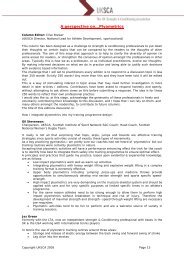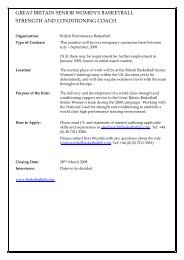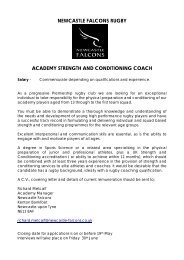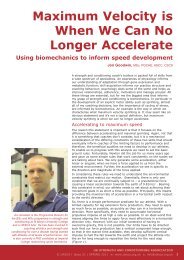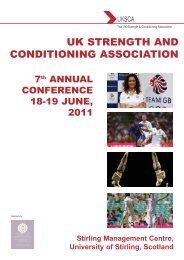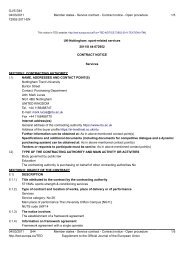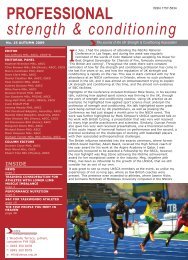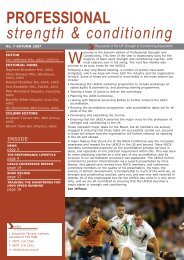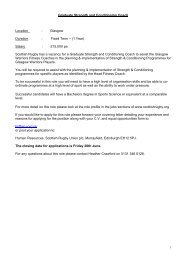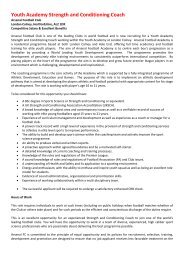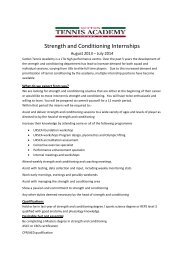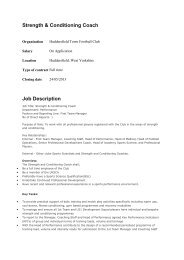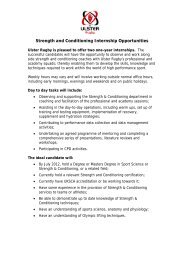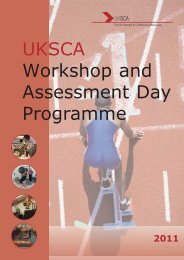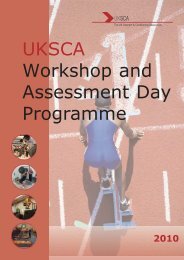uksca news june 2010.qxp
uksca news june 2010.qxp
uksca news june 2010.qxp
You also want an ePaper? Increase the reach of your titles
YUMPU automatically turns print PDFs into web optimized ePapers that Google loves.
interested in the training that went on between the<br />
testing. I decided to take a bit of gamble and sat the<br />
first NSCA strength and conditioning accreditation to<br />
take place in the UK. Soon after that, I took up a<br />
position with England Netball, which was one<br />
of the first posts in the UK specifically<br />
for S&C. Around the same time,<br />
British Gymnastics asked me<br />
back as a consultant in a<br />
similar capacity. Following<br />
this, I took up the<br />
position of regional<br />
director of S&C in the<br />
West Midlands<br />
branch of the E.I.S.,<br />
which I did for 4<br />
and a half years<br />
before leaving to<br />
open up Smart<br />
Fitness.<br />
SP: What drove<br />
the decision to<br />
open up your own<br />
facility?<br />
NG: I saw lots of<br />
good athletes run<br />
out of funding and<br />
have no strength and<br />
conditioning support<br />
to turn to, other than<br />
personal trainers in<br />
health clubs. There were<br />
also lots of good athletes and<br />
age groupers with no access to<br />
elite support, and I questioned the<br />
service these guys were getting in the<br />
health and fitness clubs from personal<br />
trainers. I decided to put my money where my mouth<br />
was, and make the quality service that was available to<br />
elite athletes also available to the general population<br />
and sub-elite athletes. I should say, that over the last<br />
few years my views have changed a bit and I’ve found<br />
there are personal trainers out there who are very<br />
good at what they do. It’s like any industry, there are<br />
good and bad practitioners and I’m not so quick to<br />
jump to conclusions now.<br />
SP: Private S&C facilities are quite a rarity in the U.K.<br />
compared to the States. Do you think that we are likely<br />
to see more of these types of facilities emerge in the<br />
next few years?<br />
NG: More and more are starting to pop up. There is<br />
definitely a trend towards more performance based<br />
fitness. If you look at the popular magazines like Men’s<br />
Health, the content has changed over the past 10<br />
years to now include squats, snatches, metabolic<br />
conditioning etc., so I think people are waking up to<br />
the fact that they were built to move, not just be sat<br />
on machines. The demand is definitely there.<br />
SP: What advice would you give to coaches considering<br />
making a similar move and opening up their own<br />
place?<br />
NG: Location is everything. Your facility needs space<br />
and you need to get the best kit your budget can<br />
withstand because people will recognise the quality.<br />
You need to hire good staff who have a thirst to be in<br />
the industry. Also, don’t assume that because you have<br />
worked in elite sport that everyone will be falling over<br />
themselves to come and train with you.<br />
SP: You’ve lectured quite extensively on recovery and<br />
regeneration. What led to this being a particular area<br />
of interest for you?<br />
NG: This became a big area of focus for people during<br />
the England Rugby world cup winning era,<br />
but I was first exposed to it at England<br />
Netball. Looking back, they were<br />
really ahead of the curve with<br />
contrast baths etc. However,<br />
the light bulb really turned<br />
on when listening to a<br />
talk Vern Gambetta did<br />
on training a few<br />
years back. Vern<br />
spoke about a trend<br />
with coaches who<br />
were focusing on<br />
improving the last<br />
1% of<br />
performance, but<br />
the same coaches<br />
often forget about<br />
the other 99%! I<br />
took the same<br />
idea and thought<br />
about relating it to<br />
recovery. I was<br />
seeing athletes doing<br />
a lot of the ‘bells and<br />
whistles’ stuff<br />
(massage, ice baths<br />
etc), but the very same<br />
athletes were drinking red<br />
bull, eating carrot cake and not<br />
getting enough sleep! From<br />
there, I sat down with Mark Jarvis and<br />
came up with the Recovery pyramid. We<br />
basically developed a process, much like training,<br />
where in order to do the fancy stuff, you had to take<br />
care of the basics first. It all links back to the idea of<br />
the 24hour athlete. We maybe only see our athletes<br />
1-2 hours a day and they can potentially go mess<br />
everything up in the other 22 hours of the day by not<br />
following appropriate regeneration techniques.<br />
SP: What are some of the practices you put in place to<br />
track the recovery and regeneration of your athletes?<br />
NG: At England Netball we had training diaries, which<br />
were really useful. We could upload the information<br />
and after a couple of months really start to see trends.<br />
I also have a look at athletes jump height and ground<br />
contact time at the start of sessions to see where we<br />
are. I have to say, a lot of the stuff I use comes more<br />
from the art of coaching as opposed to the<br />
recommendations printed in text books. For example,<br />
when you work with athletes long enough, you can<br />
meet them at the door and during the few minutes’<br />
walk to the gym know if it’s going to be a big session<br />
or not. While on tour, the netball girls would do<br />
multiple jumps for distance and I would measure them.<br />
However, you could also look the other way and just<br />
listen to the foot contacts and tell from the thuds and<br />
slams that maybe it wasn’t a day for high volume.<br />
SP: There seems to be a move away from the<br />
programming and monitoring of time under tension<br />
(T.U.T.) in training programmes recently. Why do you<br />
stick with it?<br />
NG: Alywn Cosgrove came up with the idea of how the<br />
industry will often over react or under react to<br />
26<br />
UK STRENGTH AND CONDITIONING ASSOCIATION<br />
© UKSCA | Issue 18 | Summer 2010 w: www.<strong>uksca</strong>.org.uk e: info@<strong>uksca</strong>.org.uk



